Bago with the glorious past name Pegu or Hanthawaddy, is the capital port city of Bago area, in Southern Myanmar and 80km Northeast of Yangon.
According to the legend, the Bago region seems has the long history. The name of this land was mentioned in about the years of 850 by Arab geographers. They supposed that two Mon princes from Thaton arrived in Pegu in 573. From 1056, Burmese from Bagan came to rule the city before Bagan was overthrown by the Mongols in 1287 made it returned to the Mon. In the 15th century, Hanthawaddy was not only the capital of Kingdom of Mon Ramanadesa – low land of Burmar, but also the commercial and Theravada Buddhism center of the country.
After some more changes by different dynasties and rulers, in 18th century, King Alaungpaya retook the city from Mon people and destroyed it in 1757. Bago was rebuilt by King Bodawpaya (1782 - 1819), and then the Pegu river changed the direction brought about topography of the city. It made Bago separated from the sea and lost its importance. After the British-Burese War II, the British ruled the city.
Lying on the river, the alluvial soil brings this land the development of rice agriculture. It is also famous for wood-producing and many long-standing architectural works with high historical value attracting tourists every year.
You are recommended to visit Bago from Nov to Apr with dry, temperate weather and festival atmosphere here.
There are some main interesting destinations of this ancient land that you should not miss on the journey in Myanmar.
Reclining Buddha Statues
Shwethalyaung is a famous work in Bago, located in the West of the City. The statue was built in 994 by the Mon ruler, during the reign of King Migadepa. After Bago was completely destroyed by the Burmese in 1757, this Buddha construction was abandoned in the rainforest. In 1880, the statue was found under a grove of trees in the forest, and was restored several times to keep its original form.
The Buddha statue is huge with 55 meters long and 16 meters high. It is the second largest reclining Buddha in the world (just follow after Win Sein Taw Ya, near Mawlamyine, Myanmar). The large statue with the position of lying in relaxation has the vast hall inside is set up by iron and images of the Buddha's life are decorated at its back side.
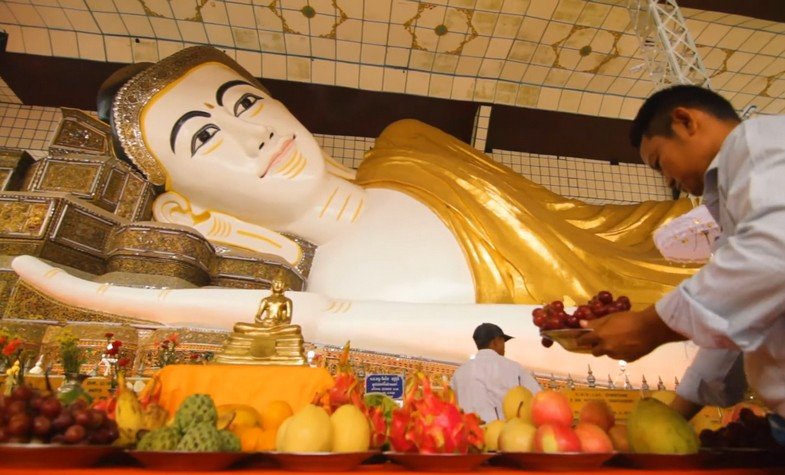
Shwethalyaung Reclining Buddha Statue
Just 5 minute-drive from Shwethalyaung Statue is the big outdoor reclining statue of Buddha named Mya Tha Lyaung. The Burmese had contributed to build this statue in 2001. It is supposed that the statue’s position represents the last phase of Buddha before he enters to the nirvana. He lies on his right side and places the head on his right hand.
Not like many other statues in Myanmar that are surrounded by pagodas and stupas, Mya Tha Lyaung is an individual reclining statue.
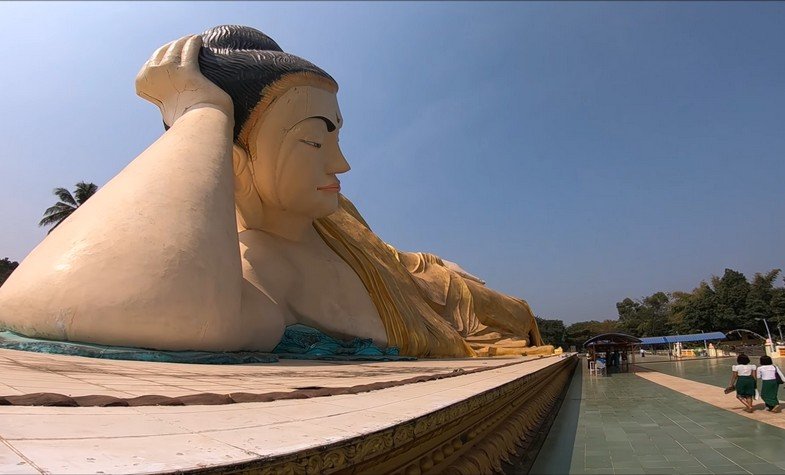
Mya Tha Lyaung Reclining Budhha Statue
Coming to visit these massive constructions, you will admire the work and the efforts of Burmese in preserving and hand down generations the traditional religion and beliefs.
Kanbawzathadi Palace
The Palace is one of the prime tourist destinations of the land Bago.
King Bayunnaung is known as the founder of Myanmar Empire II. In 1556, after the first city of Hantharwaddy was relocated, he decided to construct the new palace in South of Shwemawdaw Pagoda and named it Kanbawzathadi.
Follow the old Burmese history books, it has 76 rooms and halls before was burnt in 1559.
In 1993, the Archaeologies excavated the foundation of the palace and explored many bricks, plinths by Teak wood with inscriptions, and 1800 lime-stone Buddha’s images. The Vestiges of the city hall with twenty gates can be visited today. And the Great Audience Hall (the Lion Throne Room) and Bee Throne Hall were constructed again as you can see today.
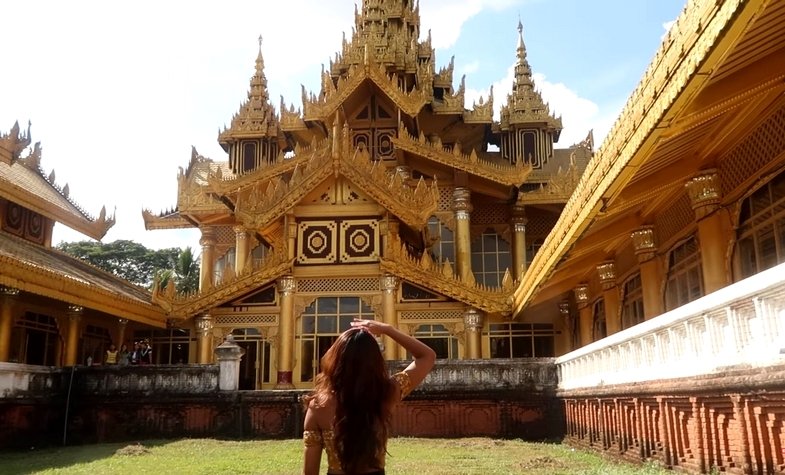
Kanbawzathadi Palace
Kyaik Pun Pagoda
Locates near the city center, lies in the lush, green countryside next to the ancient ruins that have not been repaired, it is convenient for visitors take the visit to the Kyaik Pun Pagoda.
This pagoda was built by King Migadippa in the 7th century and renovated by King Dhammazedi in 1476. It is famous for the Four Buddha statues in the posture sit against a brick pillar. Four Buddhas are Kakusadha, Konagamana, Kassapa and Gautama looking to four directions. This impressive and unique statue is 27m height and is very strictly preserved.
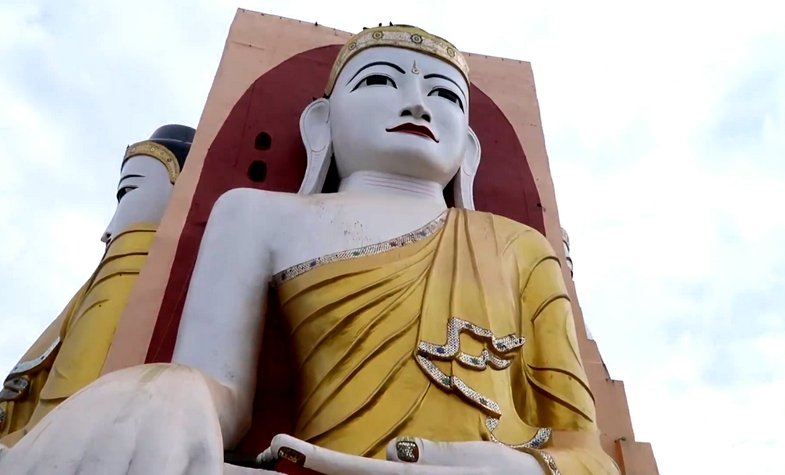
Four 27-meter-height Budhha statues lean against a pillar
Snake Monastery
Two big stone blocks to the Southwest of Kanbawzathadi Palace is the Snake Monastery. It is believed that the monastery dedicated for an abbot of Buddhism, which has been reborn in shape of a huge Burmese python. Many pilgrims and tourists come here to pray and pay their respects to the giant serpent, whose unusual length is 9 meters from head to toe.
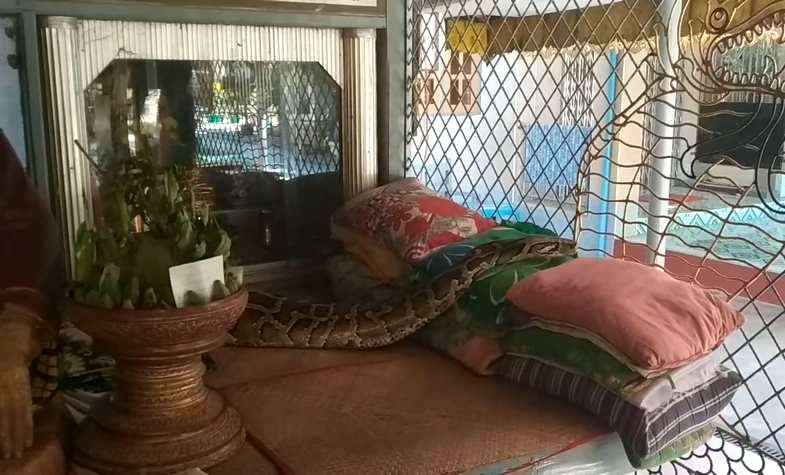
Many Buddhists believe the presence of pythons bring power and luck to the temple
Golden Rock Pagoda
Golden Rock Pagoda or Kyaikhtiyo pagoda is one of the oldest and most famous ones in Myanmar, where it is also believed to be the sacred stone that holds the hair of Buddha.
The pagoda is located on the top of Kyaikhtiyo Mountain with the altitude of over 1,000m above sea level and more than 200km from Yangon. The pagoda is located on an egg-shaped stone block with a height of 7.3m and a circumference of 15.2m. The legend said that this ancient and famous pagoda was built 2,500 years ago.
One of the points that made the pagoda famous is because it is located on a rock lying on a side of the mountain. The point of contact between the giant stone and the cliff is only about 78cm2. From a distance, it's like a stone about to fall off a cliff, but this sacred stone has survived for thousands of years.
Golden Rock Pagoda is associated with a famous legend at the door of Buddha. According to legend, when Buddha visited Kyaikhtiyo, he gave a virtuous monk his hair. This man went to see the Burmese king, asking him to store the treasure in a stone shaped like his head.
The king, who possessed magical powers, found a suitable stone in the deep sea. He brought it to Kyaikhtiyo and put it at its present location. It is believed that, thanks to the precious hair hidden in it, the special temple did not collapse.
The boat and the rope were turned to stone, and were named Kyaukthanban Pagoda, located about 300m from Golden Rock to keep the stone from falling. For those who have ever toured Myanmar, admiring a stone and the temple covered with gold leaf lying on the mountain would be a unique experience.
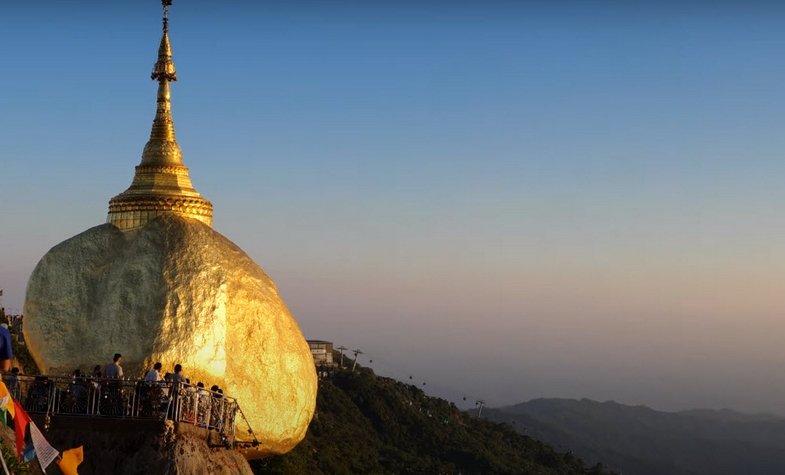
Golden Rock Pagoda
To visit the temple, visitors can take a pickup or walk through the dense forests from Kimmunsakhan to Kinpun camp at the foot of Mount Kyaikhtiyo. Myanmar people often say, driving a car to conquer the temple is also a thrilling experience when visitors will have to sway on a roaring car to climb winding 11km-long road for nearly an hour.
The last ride to the temple will be at 6pm each day. Outside of that time, visitors will have to move down the mountain by themselves.
The Golden Rock Pagoda is worth one of Myanmar's extremely famous monuments, ranked as a world cultural heritage.